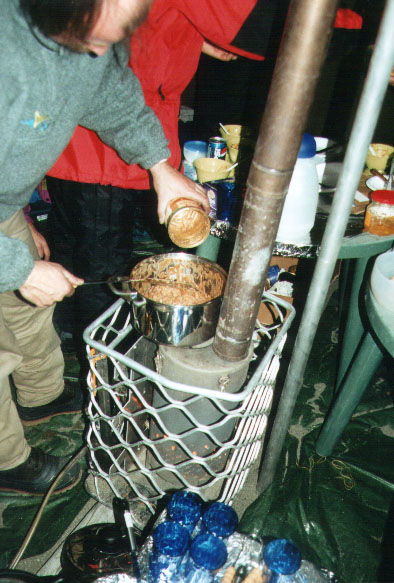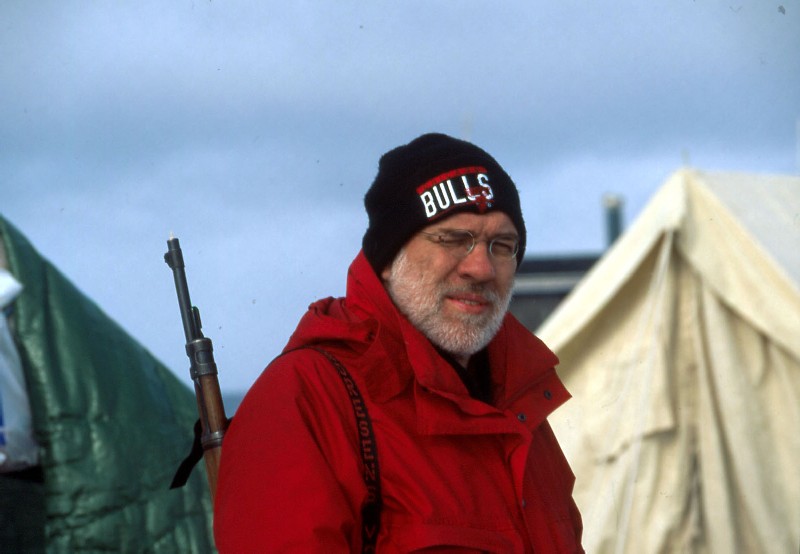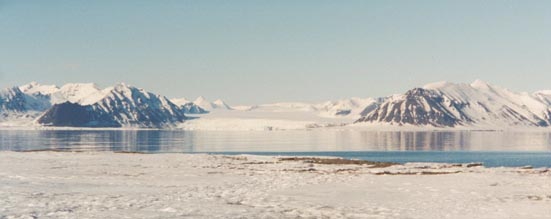Daily life |
For general use we had a lavvu tent where we
prepared the food, had dinner and we could stay for a while to get warm
again. Operations was done from two white rectangle shaped tents of which
only one was warmed up by a paraffin heater (one heater turned out to be
defective). For sleeping we used small 2 person dome shaped tents. So now
and then some people made use of the lavvu tent for sleeping, on the beds
that were placed there for sleeping or sitting.
 Although Terje did most of the cooking, other members
assisted him. The Italians offered to make their famous pastas and Marc is
now known for his bacon and eggs. As the days went on, there was less
choice in food and gradually Terje started to be creative in preparing
variations of his famous survival soup, which can be anything that is put
together in a big pot and cooked for a few hours on the stove after which
it was called to be ready (see picture ->). Although Terje did most of the cooking, other members
assisted him. The Italians offered to make their famous pastas and Marc is
now known for his bacon and eggs. As the days went on, there was less
choice in food and gradually Terje started to be creative in preparing
variations of his famous survival soup, which can be anything that is put
together in a big pot and cooked for a few hours on the stove after which
it was called to be ready (see picture ->).
Cleaning our pans,
plates and cutlery with snow and cold water was always a
hassle.
Washing yourself was kept to the minimum necessary.
As long as all people were doing this there is no problem. However, if
someone should wash himself, it would quickly be noticed by the others who
would feel guilty for not washing. That could not be tolerated and we
decided that the first who starts washing himself would be punished and
exiled to the most remote tent of the camp.
Going to the toilet
(at the beach or other arrangements) was also an unpleasant exercise.
During this necessary action, you also had to be careful that you were not
be seen by a polar bear.
Other activities included filling
the generators, filling the stoves with paraffin (200 liters was brought
to the island), cleaning the tents, adjusting the tents and anchor pins,
reinforcing the tents in case of heavy winds, bear watching, etc.
For
the rest there was time for rest, socializing, field trips, etc.
|
Security |
The area of Svalbard is also known for the
polar bears and measures had to be taken to avoid an unpleasant encounter
with this giant creature. We had two alarm pistols that could fire
<sound bullets> or flares. This should be used in the first place to
scare the polar bear and hope it would run away. In the case this would
not have effect, we had two rifles that could be used to shoot into the
ground just in front of the bear to scare him and if that wouldn’t help
either, we should eventually kill the bear. Fortunately, the latter
situation did not happen.
To avoid a sudden encounter with a polar
bear, we established a bear-watching schedule. This was a very cold
exercise and often interrupted by a visit to the lavvu or operating tent
to warm yourself up.
|
|

Gerben PA5NT on 'bear watch' duty with an old but
suitable rifle from 1932!
One day, Chris DL5NAM spotted a polar bear on the beach and alarmed us.
With great excitement, we grabbed the pistols and rifle and went outside.
No bear could be seen but we were very careful, as the beach was not
visible from our position. We fired first two rounds with the pistol
followed by two round with the rifle. We than inspected the beach but no
bear could be seen anymore, except some footprints. Later that day however
we recognized footprints of the bear around the tent that was not in use
for operations. This proofed that a bear watching schedule is absolutely
necessary for your own safety.
|
Weather conditions |
Although known from book readings and
experience by some of the team members, it was for the other members very
exciting to witness the rapid changes in weather conditions. This is
typical for Arctic regions and requires careful planning and preparations
for outdoor work and field trips.
|
|

|
|
During our stay we have experienced all
possible conditions, from snow and heavy winds till very beautiful quite
and sunny days. Temperature is not just the only factor that makes you
feel cold. The wind will multiply that by a factor 2 to 4. The picture
above shows the extremely nice weather we experienced.
|
 |

|
|